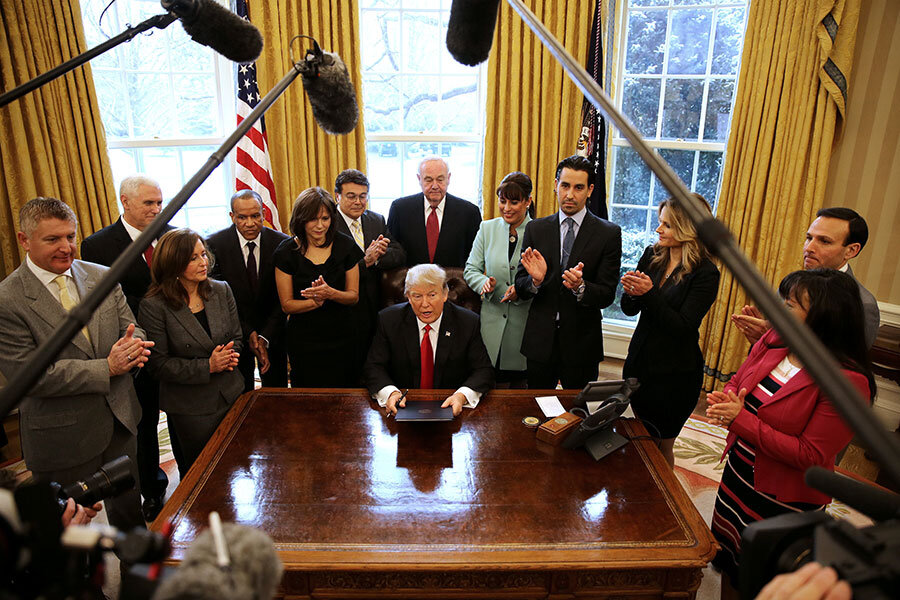Trump's executive orders: Dramatic but fatally flawed?
Loading...
Donald Trump spent the first week of his presidency signing executive actions at such a rapid pace that it’s still unclear how – or if – many can be legally implemented.
The powers of the executive branch have been steadily expanding over multiple presidencies, but President Trump’s “go fast” approach so far has set him apart from his predecessors.
In making their claims for greater executive authority, Presidents George W. Bush and Barack Obama offered careful legal justifications for their moves – and even then, courts did not accept all of them. By contrast, Trump’s orders appear to be very loosely written, legally speaking, opening broad latitude for legal challenges.
The advantage has been the Trump administration’s ability to offer the appearance of fulfilling campaign promises quickly and decisively. The drawback is that huge swaths of his early agenda could be swept aside by the courts or fail to have a significant effect if not supported by later legislation. It is an approach that appears to favor speed and splash over precision and lasting impact, experts say.
“He spoke the game of a very powerful president” during the campaign, says Paul Nolette, a political scientist at Marquette University in Wisconsin. “So it’s not surprising that you have him now in office trying to use all these tools that have built up over time to push policy goals.”
But “speed alone is not the only value that needs to be considered when it comes to executive orders and executive actions,” he adds. “There’s compliance with the law and proper vetting.”
Trump vs. Obama and Bush
The Trump administration has said that the Justice Department’s Office of Legal Counsel approved Friday’s temporary ban on refugees and citizens from seven Muslim countries entering the United States. A CNN report contradicts that claim, while Buzzfeed cites a senior Justice Department official as saying the office reviewed the order but did not say whether it was legal. The office itself has declined to comment.
Several legal experts say the orders don’t give the appearance of having been carefully crafted.
Trump, after all, is hardly the first president to try to expand the reach of the executive branch. Mr. Bush broadly interpreted the constitutional powers of the presidency to exert unilateral power in the war on terror. Mr. Obama reinterpreted existing statutes to enable executive actions on the deportation of illegal immigrants and the regulation of greenhouse gas emissions.
But both Bush and Obama “understood that if they’re going to make a claim of authority, they have to explain that,” says William Marshall, a professor at the University of North Carolina School of Law, and a deputy White House counsel in the Clinton administration.
“Having to explain it is part of the constraints on what they’re able to do,” he adds. “I’m not seeing that kind of explanation from the Trump administration.”
The legal ambiguity has already led several courts to rule on Friday’s travel ban. Orders from five different district courts over the weekend granted various forms of relief to people affected by the order. Some of the court orders will be in effect only for a few days, but they speak to the legal concerns surrounding the move.
On Monday evening, Acting Attorney General Sally Yates, an Obama appointee, said that she has directed the Justice Department not to defend the ban in court, saying she's not convinced "the executive order is lawful." Her decision was described as striking, but symbolic. Trump fired her the same evening.
Some of Trump’s other executive orders may also be legally vulnerable. His order compelling local police to enforce federal immigration law or risk losing federal funding to the city, for example, could run afoul of the landmark Supreme Court ruling on the Affordable Care Act. The court ruled that the Obama administration could not use a similar threat to compel states to accept an expansion of Medicaid.
A bid for 'symbolic power'?
What is distressing for some conservatives is that the Trump administration’s approach could damage the long-term prospects for policies they have sought to change for years.
Describing Trump’s immigration order as “blunderbuss and broad,” the Wall Street Journal’s editorial board cautioned that “the danger of moving too fast without careful preparation and competent execution is that he is building up formidable political forces in opposition.”
Not all of Trump’s executive actions are on shaky legal ground. His order reinstating an international ban on abortion counseling, for example, has been implemented in some form by every Republican president since Ronald Reagan. His Day 1 order to freeze federal government hiring for 90 days is also within traditional presidential authority.
But for now, many of Trump’s actions seem to be less interested in building executive power than dramatically attempting to wield it as “symbolic politics,” writes Benjamin Wittes, a senior fellow at the Brookings Institution, on the Lawfare blog.
To some, such actions are consistent with Trump’s rhetoric on the campaign trail.
“You have a president coming into office who promised a lot of stuff, who promised to do things differently, who claimed at one point: ‘I alone can fix it,’ ” says Professor Nolette. “The lack of the typical process used to generate executive orders and actions is different, but I would say at the end of the day it’s not surprising.”








